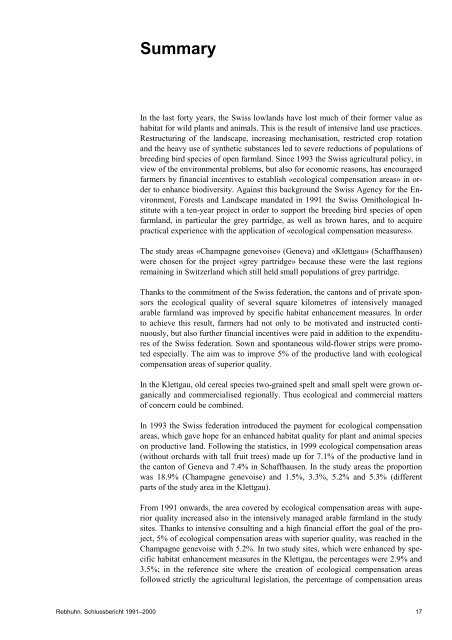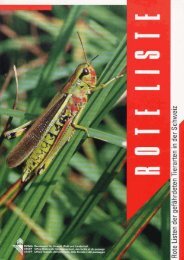Rebhuhn. Schlussbericht 1991–2000 - BAFU
Rebhuhn. Schlussbericht 1991–2000 - BAFU
Rebhuhn. Schlussbericht 1991–2000 - BAFU
Sie wollen auch ein ePaper? Erhöhen Sie die Reichweite Ihrer Titel.
YUMPU macht aus Druck-PDFs automatisch weboptimierte ePaper, die Google liebt.
Summary<br />
In the last forty years, the Swiss lowlands have lost much of their former value as<br />
habitat for wild plants and animals. This is the result of intensive land use practices.<br />
Restructuring of the landscape, increasing mechanisation, restricted crop rotation<br />
and the heavy use of synthetic substances led to severe reductions of populations of<br />
breeding bird species of open farmland. Since 1993 the Swiss agricultural policy, in<br />
view of the environmental problems, but also for economic reasons, has encouraged<br />
farmers by financial incentives to establish «ecological compensation areas» in order<br />
to enhance biodiversity. Against this background the Swiss Agency for the Environment,<br />
Forests and Landscape mandated in 1991 the Swiss Ornithological Institute<br />
with a ten-year project in order to support the breeding bird species of open<br />
farmland, in particular the grey partridge, as well as brown hares, and to acquire<br />
practical experience with the application of «ecological compensation measures».<br />
The study areas «Champagne genevoise» (Geneva) and «Klettgau» (Schaffhausen)<br />
were chosen for the project «grey partridge» because these were the last regions<br />
remaining in Switzerland which still held small populations of grey partridge.<br />
Thanks to the commitment of the Swiss federation, the cantons and of private sponsors<br />
the ecological quality of several square kilometres of intensively managed<br />
arable farmland was improved by specific habitat enhancement measures. In order<br />
to achieve this result, farmers had not only to be motivated and instructed continuously,<br />
but also further financial incentives were paid in addition to the expenditures<br />
of the Swiss federation. Sown and spontaneous wild-flower strips were promoted<br />
especially. The aim was to improve 5% of the productive land with ecological<br />
compensation areas of superior quality.<br />
In the Klettgau, old cereal species two-grained spelt and small spelt were grown organically<br />
and commercialised regionally. Thus ecological and commercial matters<br />
of concern could be combined.<br />
In 1993 the Swiss federation introduced the payment for ecological compensation<br />
areas, which gave hope for an enhanced habitat quality for plant and animal species<br />
on productive land. Following the statistics, in 1999 ecological compensation areas<br />
(without orchards with tall fruit trees) made up for 7.1% of the productive land in<br />
the canton of Geneva and 7.4% in Schaffhausen. In the study areas the proportion<br />
was 18.9% (Champagne genevoise) and 1.5%, 3.3%, 5.2% and 5.3% (different<br />
parts of the study area in the Klettgau).<br />
From 1991 onwards, the area covered by ecological compensation areas with superior<br />
quality increased also in the intensively managed arable farmland in the study<br />
sites. Thanks to intensive consulting and a high financial effort the goal of the project,<br />
5% of ecological compensation areas with superior quality, was reached in the<br />
Champagne genevoise with 5.2%. In two study sites, which were enhanced by specific<br />
habitat enhancement measures in the Klettgau, the percentages were 2.9% and<br />
3.5%; in the reference site where the creation of ecological compensation areas<br />
followed strictly the agricultural legislation, the percentage of compensation areas<br />
<strong>Rebhuhn</strong>. <strong>Schlussbericht</strong> <strong>1991–2000</strong> 17



